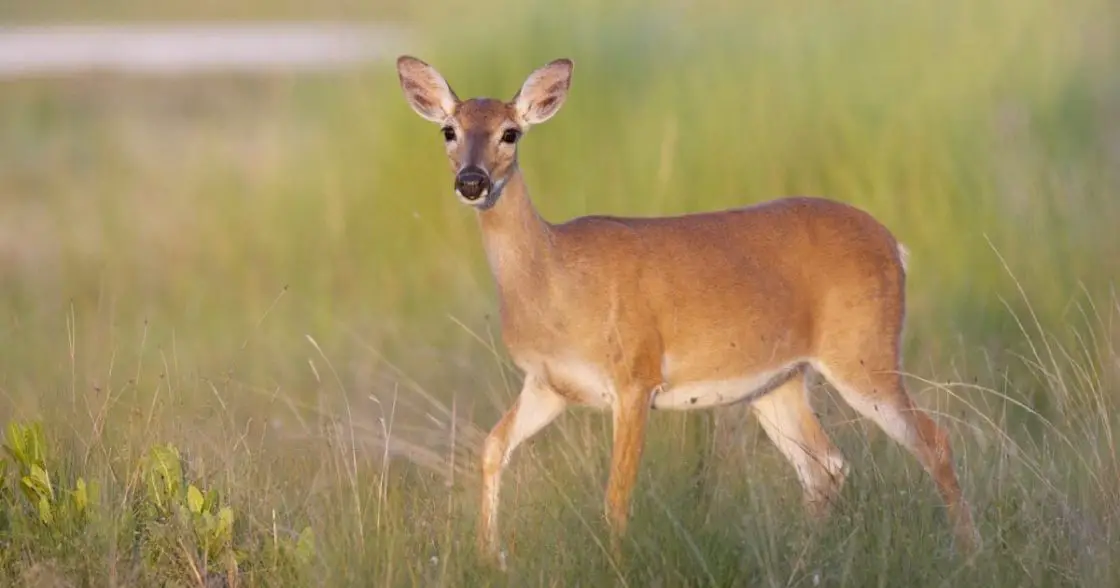Key deer are a subspecies of whitetail deer. They can only be found in the Florida Keys, which is where they got their name. Keep reading to learn everything you need to know about this little-known deer species.
We’ll find out how to recognize key deer, their behavior, and what their conservation status is.
Key Deer Appearance
Aside from their small stature, key deer look like most other species of whitetail deer.
They have a light brown coat. Young deer, known as fawns, will often have spots in their coat.
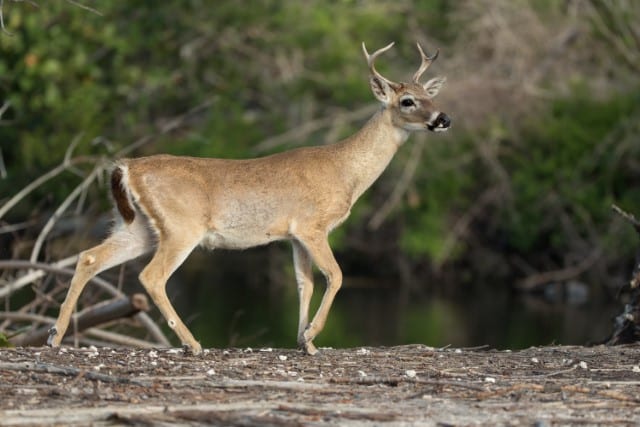
Male deer will develop antlers. While their antlers are growing, they will have a soft, velvety texture which is shed prior to mating season in the fall.
The antlers will be shed at the end of the mating season and their antlers are re-grown during the spring.
This is a trait common to most deer species and is not unique to this one. Only male key deer grow antlers.
The only real distinguishing feature between key deer and other subspecies of whitetail is their small size.
How Big Are Key Deer?
On average, key deer are much smaller than regular White Tailed Deer.
Their small size makes it easy for it to move around its environment. Their tiny stature also makes navigating the marshes easier.
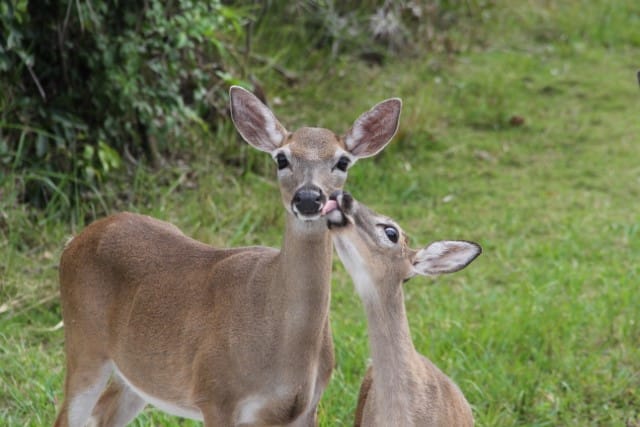
It also means they are very fast. They can escape predators very quickly.
So, if you see a key deer and don’t know what it is, you might think it’s a baby whitetail.
| Male Key Deer | Female Key Deer |
|---|---|
| 30 inches tall at the shoulder | 26 inches tall at the shoulder |
| 55 – 75 pounds | 44 – 64 pounds |
Grown male whitetail deer, on the other hand, can weigh up to 300 pounds.
The tallest whitetail deer can measure up to 87 inches. That’s nearly three times as tall as a grown male key deer.
Key deer are smaller because they have been an isolated subspecies for a long time. Water separates the Florida Keys from other areas with whitetail deer.
As a result, these deer haven’t mixed their genes with other populations for long enough and as a result they have developed their own distinct characteristics. This is similar to what happened with the Seneca White Deer herd – although they were cut off from other deer by a tall fence.
Key Deer: Geography and Habitat
Key deer only live in the Florida Keys. They were once found all over the Florida keys.
However, development has interfered with their natural habitat. Currently, these deer can only be found in a small section of these islands.
Key deer can be found between Sugarloaf Key and Bahia Honda Key.
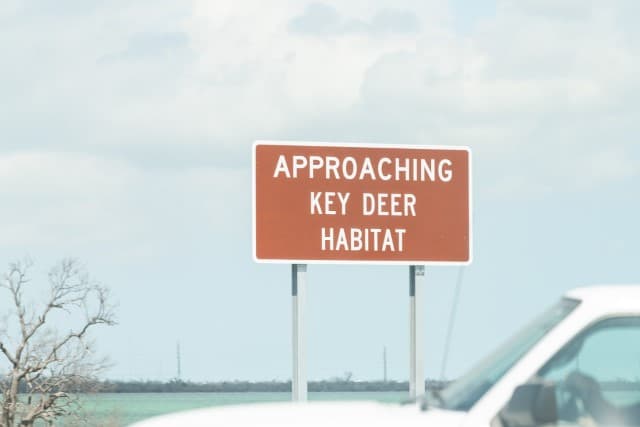
You’re more likely to see this kind of deer during the wet season, when there is more rainfall. During the dry season, however, they’re much less visible.
However, they are harder to find during the dry season. During that time of year, almost all Key deer spend all their time on Big Pine Key.
This is a semi-tropical area. However, the landscape is more diverse than you might think.
It’s not all beaches and sunshine. These cervids are well-adapted to every aspect of the wetlands.
They can be found in the mangrove forests, piney wetlands, and even in the more inland forests.
Deer will only drink freshwater, but they can sometimes be found around the beach. They are much better swimmers than other species of deer, though all deer can swim.
Species History
There is evidence that Key deer have existed since at least the 1500s, but they probably existed as a subspecies long before that.
During the sixteenth century, a Spanish sailor taken captive by Native Americans in the Florida Keys recorded seeing this deer.
Up until the twentieth century, the hunting of Key deer was quite common. This practice was banned in 1939 to save the species.
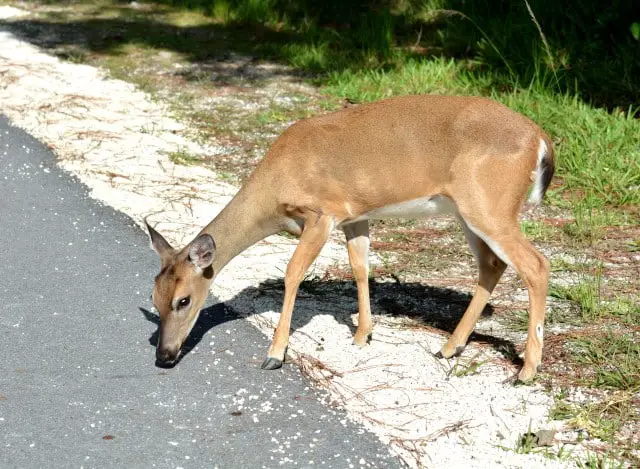
In the early 1950s, a wildlife refuge was established to prevent hunting. The population soon started steadily increasing.
Recently, it has been estimated that there are anywhere between 700 to 900 of these deer.
However, this species still has endangered status.
Hunting isn’t the main threat to this species.
Instead, development and climate change are the main threats to the Key deer’s survival.
Key Deer Diet
While herbivores, deer are known for eating just about anything, and this species is no exception. They can be a problem for those looking to plant a garden in the Florida keys.
However, a key deer’s diet is pretty diverse even without gardens.
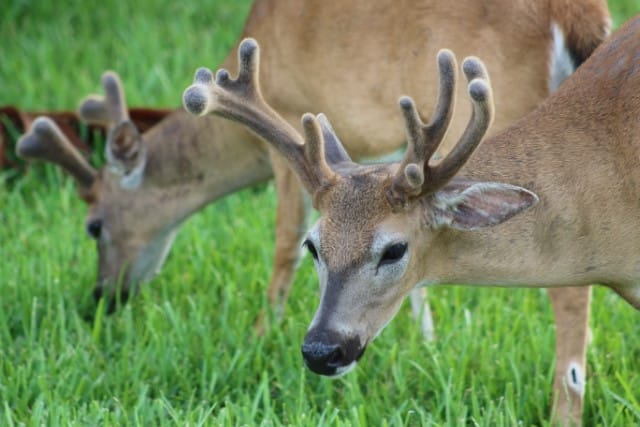
It has been estimated that this deer feeds on more than 150 different species of plants. The most important items in their diet are mangroves and berries.
Mangroves are trees that can grow in brackish water. Deer will eat just about any part of the tree and won’t shy away from eating bark.
As mangrove trees are destroyed, deer turn to gardens. They love eating fruits since they have a high sugar content.
Additionally, they sometimes eat ornamental perennial and annual plants and flowers.
Deer cannot drink salty or brackish water. Brackish water is a mixture of salt and freshwater. It isn’t healthy for deer.
This is another reason they often head into people’s gardens. Do you live in the Florida Keys and have a fountain? You’ll probably find some of the local deer drinking from it.
Since the Key deer’s natural habitat is being destroyed, you might be tempted to feed them. However feeding deer isn’t healthy for them and will often cause a bigger problem.
Deer have extremely sensitive stomachs and digestive systems. They should never be fed human food.
Feeding deer fruit and other plants that might seem natural isn’t a good idea, either. It will only make the deer reliant on you for food. This will keep them away from their natural habitat and it could make them sick.
Key Deer Behavior
In most ways, Key deer behave like other whitetail deer. One difference, however, is that they’re more people friendly.
The Florida Keys are popular with residents and tourists alike. That is why these cervids have become accustomed to being around people.
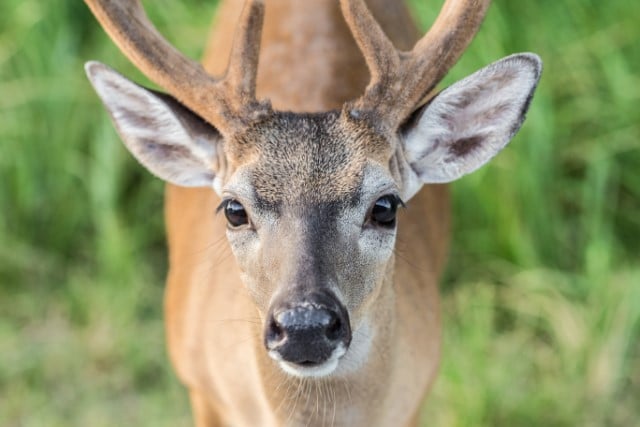
It is not uncommon for these deer to wander into people’s backyards. They can often be found on the roads or wandering around. Car collisions make up a significant portion of deer mortality in the Florida Keys.
As for most species, the key deer’s mating season is during the fall. It peaks between the months of October and December.
Key deer tend to be less territorial or aggressive than other species. Female deer will tend to live together in matriarchal groups for several generations.
When the breeding season is not happening, bucks will bed and live together. During the mating season, they get a bit more confrontational and don’t get along as well.
Key deer are not nocturnal – rather they are crepuscular creatures. This means they are most active during dawn and dusk. They are also fairly active at night, which is one reason why car collisions are frequent. They are extremely fast and hard to see going by.
Now You Know About Key Deer
Key deer are a relatively unknown species. This is because they can only be found in the Florida Keys. So, during your next vacation, keep an eye out for them. Just make sure not to feed them.
To sum things up, their smaller size is the the main distinguishing feature between Key deer and regular whitetail deer.
These beautiful deer are listed as an endangered species because their environment is being threatened. If the Florida Keys disappear, so will these cervids. Conservation efforts are underway to stop that from happening.

